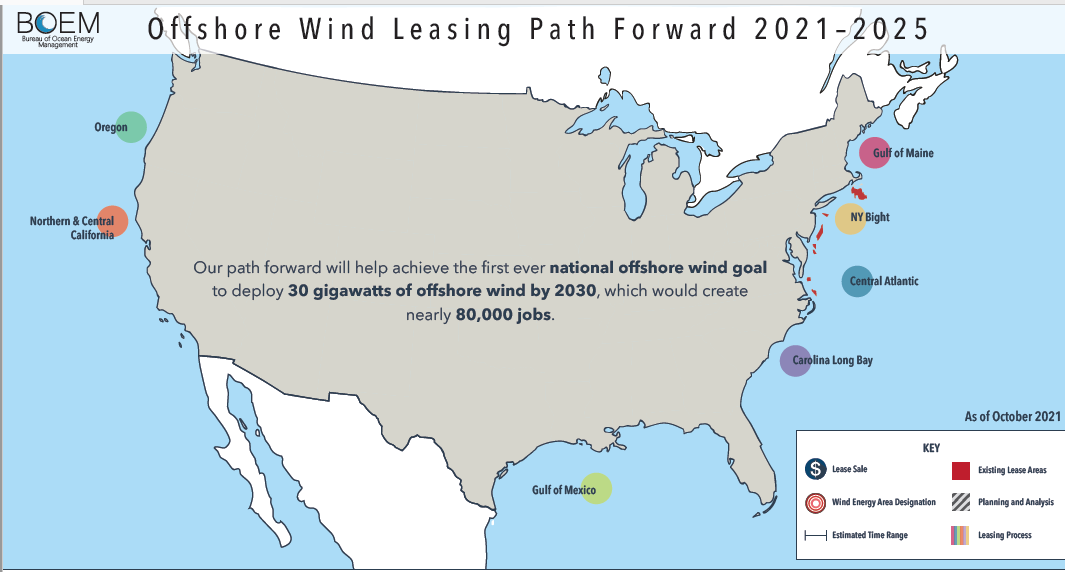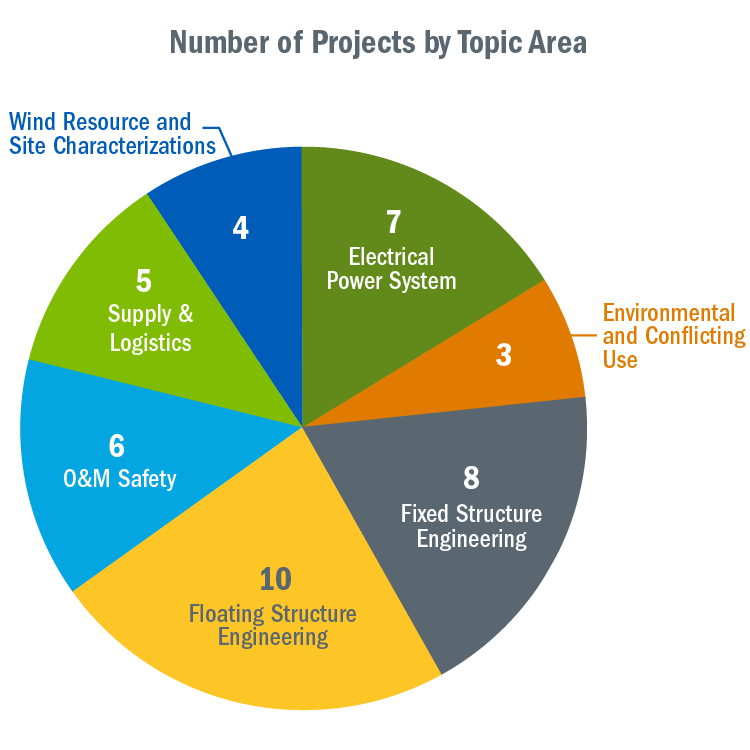Need a little clean energy pick-me-up? Offshore wind is offering more and more excitement as it looks to become a large-scale reality off our shores. Here’s what’s going on in five categories I’m watching.
1. More lease areas coming
One key consideration is where the turbines might go. On this score, the Biden administration has stepped up to the plate in a big way. Last month, Interior Secretary Deb Haaland announced plans for the government to auction offshore wind leasing rights for as many as seven additional areas by 2025, to complement the dozen-plus existing leases.

How the lease areas get defined will depend on what potential conflicts the process uncovers. But here’s where the Interior Department says it will be looking: “the Gulf of Maine, New York Bight, Central Atlantic, and Gulf of Mexico, as well as offshore the Carolinas, California, and Oregon.”
That list includes potential places near existing leases, including in the Bight (south of Long Island/off New Jersey) and in the Central Atlantic. But it also includes new areas, notably off Maine and the West Coast, where deeper water will mean that floating wind turbines will come into play, and in the Gulf of Mexico.
And now the Bureau of Ocean Energy Management, the federal agency in charge of offshore leasing, is inviting comments on the proposed area off the Carolinas, and inviting the public to help it think about possibilities in the Gulf of Mexico.
2. More states stepping up
States have been key drivers for offshore wind, and they continue to lead. A few examples:
- Nine Democratic and Republican governors jointly offering suggestions in June to the Biden administration on how to help offshore wind move even more quickly,
- California helping open up that new front with legislation in September that requires the state’s energy commission to develop a strategic plan for bringing offshore wind into the state’s push for 100% carbon-free electricity,
- New Jersey, also in September, breaking ground on the first port designed specifically with offshore wind in mind, and
- In Massachusetts, the legislature and governor moving toward allocating millions of federal economic recovery dollars to offshore wind infrastructure.
Cities are getting into the act too: New York Mayor Bill DeBlasio announced in September a $191-million investment plan to make the city “a leading destination for the offshore wind industry,” with a focus on “sites and infrastructure, business and workforce, and research and innovation.”
3. More innovation and technology developments
Innovation keeps making offshore wind even more attractive, and that innovation shows no signs of slowing down. The Department of Energy (DOE) reports that the National Offshore Wind Research and Development Consortium—a collaboration among states, the federal government, and the Electric Power Research Institute—has now made 40 investments to “reduce costs and risks” around offshore wind.

(Source: NOWRDC, via Department of Energy)
Offshore wind turbines themselves keep getting more impressive. Less than a year ago I was waxing philosophic about a new 13 megawatt turbine (enough, I calculated, to power a home for a day in 7 seconds). Now comes the news that the Empire Offshore Wind project coming soon to the New York Bight will be using 15 megawatt turbines from Vestas. “Each rotation of a 15 [megawatt] turbine,” Vestas says, “will be capable of powering a New York home for about 1.5 days.”
Also in the innovation category is more attention to transmission. That includes a just-released Offshore Wind Transmission Study from PJM, the grid operator for the Mid-Atlantic, on what it might take to upgrade land-based transmission to handle offshore wind power and all other renewables needed to meet member states’ requirements by 2035. (The answer? $2.16 billion to $3.21 billion.) The new attention to transmission also includes a new DOE analysis of what we know, and don’t, about transmission for the Eastern seaboard.
4. More on doing it right for workers
The way to do offshore wind well is to do it right, including when it comes to labor and jobs. So thankfully there are promising developments in that arena, too:
- A project labor agreement in July between the Southeastern Massachusetts Building Trades Council and Vineyard Wind will ensure that union labor will power the construction of the first large-scale offshore wind farm in the Americas.
- For the largest project proposal to date, the Coastal Virginia Offshore Wind project, an agreement in September among North America’s Building Trades Unions, their state affiliate, and local utility Dominion Energy Virginia has the parties “reaffirm[ing]… their commitment to the participation of a unionized workforce.”
And, while the timing for US manufacturing of different components is going to depend on a lot of factors, that reality is now even closer, with all the jobs that could come with it, with a just-announced move by Siemens Gamesa Renewable Energy to set up the country’s first offshore wind turbine blade facility in Portsmouth, Virginia.
5. More on doing it right for the environment
Doing it right also means paying serious attention to wildlife and habitat issues, and using science to ensure progress. To that end, it’s important to see progress on the environmental reviews for more prospective offshore wind projects, including Atlantic Shores—a pair of projects proposed for off New Jersey—and Mayflower Wind, slated for south of Massachusetts.
It’s also good to see the DOE investing in “wildlife and fisheries monitoring” with $13.5 million going to four research teams and projects looking at the East and West Coasts.
And more turbines… soon
Progress in all those areas comes together when turbines actually start cranking out clean electrons. On that front, one promising recent development was Vineyard Wind’s announcement that it had “reached financial close”—meaning it had lined up all the investment it needs to start construction.
Why more can be good
As someone who spends a lot of time thinking about climate change and consumption, I sure realize that “more” isn’t always a plus. But in this case: Well-sited offshore wind is powerful new tool for us—to clean up our electricity mix, shut down lots of dirty power plants, cut pollution and carbon emissions, and create some serious economic development opportunities.
There’s so much more to come. And I’ll welcome all of it, as soon as we can make it happen.

